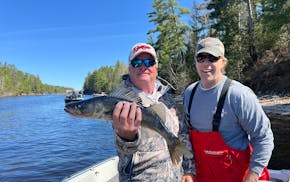The goodwill that exists among Minnesotans for conservation of the state's natural resources and especially for preservation of outdoor traditions — fishing among them — is unbounded.
That was among my thoughts last weekend during the inland walleye and northern pike opener, which some friends and I spent on Lake Winnibigoshish ("Winnie") while fishing out of McArdle's Resort on Winnie and nearby Paradise Resort on Moose Lake.
On the season's first day, Winnie was loaded with boats, most carrying an average of three anglers. An hour's drive north or so of that giant lake, Upper Red Lake also was crowded, as were, not far away, Leech and Cass lakes.
Department of Natural Resources conservation officer (CO) Andrew Goodman of Perham concurred the opener was bustling, saying it was the busiest he's seen in recent memory.
CO Aaron Larson of Tower agreed, reporting a busy opener on Lake Vermilion, while CO John Slatinski IV, working out of Ray, said he couldn't remember a recent opener as hectic.
Fishing license sales just before the opener were 7% higher than a year ago, confirming the officers' observations.
While waiting last weekend in long lines at bait shops and at boat launches, and while trolling a quarter-ounce jig in 12 feet of water on the opener (fishing partners Joe Hermes, Steve Vilks, my wife, Jan, and I had good luck), these were two of my observations:
- More women are fishing now than in previous years, a trend that in my view must continue for fishing to remain the state's premier outdoor activity.
- Perhaps counterintuitively, given the meteoric rise in popularity of competitive fishing in Minnesota among 7th-12th graders, fewer young people appear to be fishing on the opener — and at other times — than has been the case in Minnesota historically. (This could be because many school fishing competitions are for bass, not walleyes.)
The two issues are connected in my view, and how they play out, alone and together, will help determine whether fishing, Minnesota's premier outdoor pastime, continues to thrive or suffers.
The issue is important to everyone, not just anglers, because fishing is second only to camping in the amount of money ($36 billion) it contributes to the U.S. recreation economy. The funds not only underwrite fisheries management, they help ensure the presence of surface and sub-surface clean water.
According to the Department of Natural Resources, about 20% of anglers in Minnesota are women. That percentage is impressive and might be the highest among all states. But it will have to increase markedly to ensure future generations of kids are exposed to fishing and other outdoor activities in intentional ways.
That's because women generally have more influence on how a family spends its time than men do. And given that any young kid doing anything outdoors — playing in mud included — is likely to be better off psychologically and emotionally than a kid who stares at a phone or computer all day, more women (and men) of the future will, in my view, have to help kids make healthier choices, including some that include rods, reels and lures.
Diane Scott, a Future Anglers of Minnesota (FAM) board member, believes fishing might hold special promise for a kid's development.
"Our group probably interacts with 250 kids a year," Scott said of FAM. "This includes Callan Wagner, my grandson, who was my biggest reason for getting involved with FAM."
As proud as Scott is of 13-year-old Callan's developing angling prowess, she's prouder still of the fundraiser he and other FAM kids participated in. Soliciting pledges for every fish they caught in a winter tournament, Callan raised $6,885 for St. Jude's Children's Hospital, while fellow FAM member Khloe Thorson did better still, raising $7,200 for a cancer foundation.
"We challenge our young anglers not only to develop their fishing skills but to help their communities," Scott said.
Meanwhile, Women Anglers of Minnesota (WAM), the fishing group founded in 1977 to introduce women to the joys of fishing, continues to thrive. On June 8 on Lake Osakis, the group will host its 46th WAM Open Water Fishing Tournament, and members also will volunteer June 15 at Buffalo Days Fishing Klinics for Kids, and June 28 at the Jiggin' with Kids nationwide virtual fishing tournament.
Impressively, WAM also sponsors 25 high school fishing teams and, in Minnesota, also sponsors the Student Angler Tournament Trail.
Of course, these groups can't provide outdoor opportunities for all Minnesota kids. Parents also must help attempt to counter the temptations of electronics and social media with outdoor activities. In my experience, as a parent and observer of parents, that can be an uphill climb if a child isn't brought to a park or similar environment by age 2 or 3, and isn't soon thereafter taken camping, hiking, biking, fishing or otherwise doing something outdoors.
Which is why the seeming absence on this opener, as on previous openers, of young people is worrying. Not only because the future of fisheries and clean water depend on continued participation by the masses, but because society will benefit if more people spend more time outdoors.
A retired Twin Cities teacher and expert angler, Kay Hawley agrees.
A member of three fishing clubs — Minnesota Valley In-Fisherman, Twin Cities Walleyes Unlimited and WAM — Hawley this weekend is passing on the joy of fishing by helping to host the Minnesota Angler Meet-Up at Vermilion Dam Lodge on Lake Vermilion.
"We have 30 anglers here representing the three clubs, and by joining forces and learning from each other, each of us will have a greater opportunity to positively impact the Minnesota fishing community," Hawley said.
Then she went fishing, as she should.

Anderson: In early June, Minnesota fish are begging to be caught. Won't you help?

Anderson: Tails wagging, DNR officers' dogs find lost people and missing evidence
Anderson: Punish poachers more
Anderson: The Chainsaw Sisters Saloon is gone, but the Echo Trail is still a pathway to possibilities




